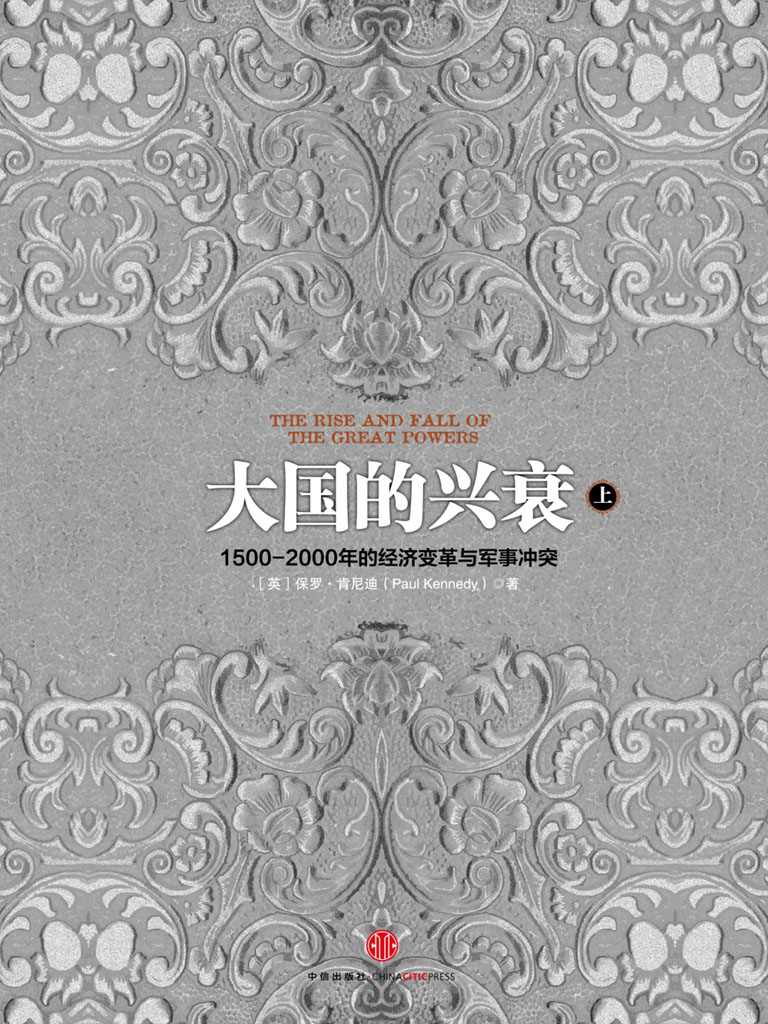|
大国的兴衰:1500~2000年的经济变化和军事冲突 |
The Rise and Fall of the Great Powers - Economic change and Military conflict from 1500 to 2000 |
|
| |
王保存 王章辉 余昌楷 译 |
Paul Kennedy[英]保罗·肯尼迪 |
|
| |
2013年1月第1版 |
1987年 |
|
| sn |
cn |
en |
detail |
| 0 |
前言 |
Introduction |
|
|
PART ONE 前工业社会 |
STRATEGY AND ECONOMICS IN THE PREINDUSTRIAL WORLD |
|
| 1 |
第一章 西方的兴起 |
Chapter 1. The Rise of the Western World |
|
| 2 |
一 明代中国 |
Ming China |
|
| 3 |
二 穆斯林世界 |
The Muslim World |
|
| 4 |
三 两个特例:日本和俄国 |
Two Outsiders—Japan and Russia |
|
| 5 |
四 “欧洲的奇迹” |
The “European Miracle” |
|
| 6 |
第二章 哈布斯堡家族争霸(1519-1659) |
Chapter 2. The Habsburg Bid for Mastery, 1519–1659 |
|
| 7 |
一 角逐的目标与纪年 |
The Meaning and Chronology of the Struggle |
|
| 8 |
二 实力与弱点 |
Strengths and Weaknesses of the Habsburg Bloc |
|
| 9 |
三 国际较量 |
International Comparisons |
|
| 10 |
四 战争、金钱和民族国家 |
War, Money, and the Nation-State |
|
| 11 |
第三章 金融革命 |
Chapter 3. Finance, Geography, and the Winning of Wars, 1660–1815 |
|
| 12 |
一 金融革命 |
The “Financial Revolution” |
|
| 13 |
二 地缘政治 |
Geopolitics |
|
| 14 |
三 赢得战争(1660-1763) |
The Winning of Wars, 1660–1763 |
|
| 15 |
四 赢得战争(1763-1815) |
The Winning of Wars, 1763–1815 |
|
|
PART TWO 工业时代 |
STRATEGY AND ECONOMICS IN THE INDUSTRIAL ERA |
|
| 16 |
第四章 工业化与力量对比(1815-1885) |
Chapter 4. Industrialization and the Shifting Global Balances, 1815–1885 |
|
| 17 |
一 欧洲之外 |
The Eclipse of the Non-European World |
|
| 18 |
二 英国充当霸主? |
Britain as Hegemon? |
|
| 19 |
三 “中等强国” |
The “Middle Powers” |
|
| 20 |
四 克里米亚战争和俄国的衰落 |
The Crimean War and the Erosion of Russian Power |
|
| 21 |
五 内战与美国 |
The United States and the Civil War |
|
| 22 |
六 德国的统一 |
The Wars of German Unification |
|
| 23 |
七 结论 |
Conclusions |
|
| 24 |
第五章 “中等强国”的危机(1885-1918) |
Chapter 5. The Coming of a Bipolar World and the Crisis of the “Middle Powers”: Part One, 1885–1918 |
|
| 25 |
一 世界均势的变动 |
The Shifting Balance of World Forces |
|
| 26 |
二 大国的地位(1885-1914) |
The Position of the Powers, 1885–1914 |
|
| 27 |
三 聪明与战争趋势(1890-1914) |
Alliances and the Drift to War, 1890–1914 |
|
| 28 |
四 总体战(1914-1918) |
Total War and the Power Balances, 1914–1918 |
|
| 29 |
第六章 两极世界的来临(1919-1942) |
Chapter 6. The Coming of a Bipolar World and the Crisis of the “Middle Powers”: Part Two, 1919–1942 |
|
| 30 |
一 战后国际秩序 |
The Postwar International Order |
|
| 31 |
二 战争策源地 |
The Challengers |
|
| 32 |
三 法国与英国 |
France and Britain |
|
| 33 |
四 幕后超级大国 |
The Offstage Superpowers |
|
| 34 |
五 无法避免的危机(1931-1942) |
The Unfolding Crisis, 1931–1942 |
|
|
PART THREE 当代和未来 |
STRATEGY AND ECONOMICS TODAY AND TOMORROW |
|
| 35 |
第七章 两极世界的稳定与变革(1843-1980) |
Chapter 7. Stability and Change in a Bipolar World, 1943–1980 |
|
| 36 |
一 “超级力量的正确使用” |
“The Proper Application of Overwhelming Force” |
|
| 37 |
二 新的战略态势 |
The New Strategic Landscape |
|
| 38 |
三 冷战与第三世界 |
The Cold War and the Third World |
|
| 39 |
四 两极世界的解体 |
The Fissuring of the Bipolar World |
|
| 40 |
五 变化中的经济格局(1950-1980) |
The Changing Economic Balances, 1950 to 1980 |
|
| 41 |
第八章 面对21世纪 |
Chapter 8. To the Twenty-first Century |
|
| 42 |
一 历史回顾与思考 |
History and Speculation |
|
| 43 |
二 平衡发展的中国 |
China’s Balancing Act |
|
| 44 |
三 进退维谷的日本 |
The Japanese Dilemma |
|
| 45 |
四 得失并存的西欧 |
The EEC—Potential and Problems |
|
| 46 |
五 矛盾重重的苏联 |
The Soviet Union and Its “Contradictions” |
|
| 47 |
六 相对衰落的美国 |
The United States: The Problem of Number One in Relative Decline |
|
| 48 |
后记 |
Epilogue |
|
| 49 |
|
Notes |
|
| 50 |
|
Bibliography |
|
| 51 |
|
About the Author |
|
| 52 |
|
Other Books by This Author |
|
| 53 |
|
Acknowledgments |
|
| 54 |
|
内容简介 |
|
| 55 |
|
出版说明 |
|
| 56 |
|
中国能否在21世纪实现伟大的复兴? |
|
| 57 |
|
推荐序_兴衰的秘密 |
|



